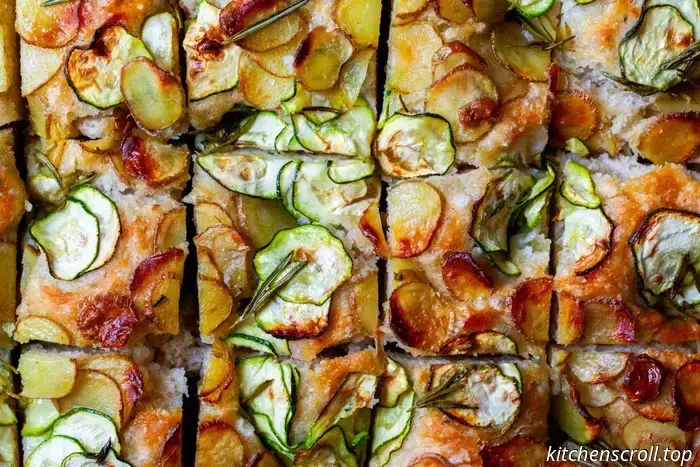
I didn't intend to get so caught up in making focaccia over the past few months, but don't I always say that? As if I forget how easily I become absorbed in a particular vision for a recipe and find it hard to let go, even when it's time to move on. As if I were someone else who made blueberry muffins 25 times one summer until she discovered what she was after. Therefore, while I shouldn't be surprised, I am: I've made an excessive amount of focaccia this spring and summer in search of the recipe I'll cherish forever. Here are five insights I gained along the way:
For a focaccia that's brown and crisp on top, a shallow pan works best: (Like these rimmed baking sheets.) While my focaccia sometimes browns and crisps reasonably well in deeper pans, like a cake pan, it never reaches the same quality.
It's surprisingly challenging to overbake focaccia: I know this might sound crazy, but practically speaking, after 20 minutes in the oven, the bread is indeed baked. However, it won’t have that crunchy top and firm edges that I adore. When I bake focaccia for at least 30 minutes, often extending to 35 or 37, and don’t take it out until it’s a deep golden brown on top, the texture becomes perfect: excellent edges while remaining hydrated and chewy inside.
No-knead is the way to go: There are numerous beloved, highly-rated, and undoubtedly excellent focaccia recipes that utilize "turns" in the dough—stretching and folding it to create a stronger dough with a more airy crumb. However, in my side-by-side tests, I didn't observe any significant improvement in texture or structure compared to when I skipped kneading the dough. Perhaps it was an error on my part. But it may not even matter since I love how the no-knead method—the easiest and least fussy approach—turns out.
Try to resist extra handling, even though it's tempting: Unfortunately, two things that are undeniably enjoyable—punching down dough after its first rise and dimpling a focaccia with oiled fingertips—don't work in our favor here and actually detract from the final airiness we want in this type of pan-baked bread. I had to control my urge to play, only dimpling a few times to achieve the focaccia you see here.
Toppings shrink, so be generous: While you can leave this focaccia plain or just sprinkle it with sea salt and rosemary, my goal was a somewhat loaded summer focaccia, which I topped with zucchini and potatoes. Sometimes, I've added thin strips of salami if everyone I'll be with eats meat. No matter how plentiful the toppings appear going into the oven, they will all shrink during baking. More toppings truly enhances the flavor.
The end result is a type of focaccia I believe we should bring everywhere this summer—picnics, potlucks, parks, barbecues, and beaches. Alternatively, it could accompany dinner with some burrata and snap peas or with a pot of classic meatballs. It could also be served with fresh ricotta and grilled vegetables or scrambled eggs and the first sungold tomatoes. It vanishes so quickly that you'll memorize this recipe in no time.
Focaccia with Zucchini and Potatoes
4 cups (540 grams) all-purpose flour
3 teaspoons (8 grams) kosher salt (I’m using Diamond brand; use half if using a different brand), plus more for vegetables
2 1/4 teaspoons or 1 packet (7 grams) instant yeast
2 cups (475ml) lukewarm water (between 100 and 115°F; warm tap water works well)
6 tablespoons (90ml) olive oil, divided, plus more as needed
8 ounces zucchini, sliced very thin
8 ounces Yukon Gold potatoes, full-sized or mini, sliced very thin
2 ounces salami, cut into thin strips (optional; not shown here)
Fresh rosemary for garnish
Flaky sea salt for garnish
Prepare the dough: In a large bowl, whisk together the flour, salt, and yeast. Add the water and 1 tablespoon of the olive oil, and use a spoon or dough whisk to combine, stirring a few times to eliminate any unmixed pockets of flour. Cover the bowl with plastic wrap and let it rise until it doubles in size and jiggles significantly, about 1.5 hours at room temperature. If you plan to use the dough later, you can transfer it to the fridge just before it's fully doubled and let it finish rising there for a few hours or overnight.
Make the focaccia: Line a 9×13-inch pan or rimmed baking sheet with a large piece of parchment paper that extends up the sides. Drizzle the parchment with 3 tablespoons of olive oil and scrape the risen dough onto it. Without pressing out the air, use your hands






Golden with wonderfully crunchy edges and a moist, chewy interior, this focaccia topped with zucchini and potatoes is the one everyone wishes you’d bring along this weekend.